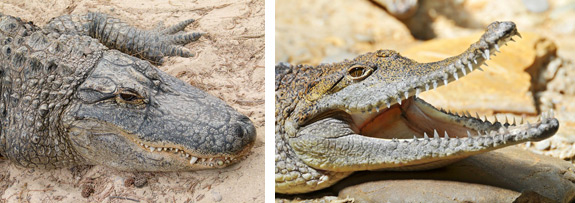
Left: Alligator, courtesy Norbert Nagel. Right: Crocodile, courtesy Flickr user Tambako the Jaguar.
This is the second of 12 Things You Should Know about Alligators and Everglades Wildlife, a free eBook.
Alligators are often confused with their close cousins, the crocodiles. The confusion is understandable, since all alligators are crocodilians, but not all crocodilians are alligators! (All squares are rectangles, but not all rectangles are squares!)
In order to know whether you’ve encountered a true alligator or a true crocodile, you can check this list of differences:
Color: Alligators are a darker, blackish-grey in color, while crocodiles are a lighter, olive green or brown color.
Snout: Alligators have a wider, U-shaped snout, while crocodiles have a pointier, V-shaped snout.
Water: Alligators prefer fresh water, while crocs tend to prefer saltwater or brackish water, which is a combination of saltwater and freshwater. This is because most crocodiles have glands in their mouths to expel salt from their systems. Alligators do not possess this gland.
Habitat: Alligators are native to the Southern United States (like the Florida Everglades!) and China. Crocodiles are found in Africa, Australia, India, Central America and in the Pacific.
Aggressiveness: Although both alligators and crocodiles can be dangerous (so be careful!), alligators are usually much less aggressive than crocodiles. When cleaning alligator pools, some zookeepers can tread around alligators without eliciting a response. Crocodiles almost always react aggressively.
